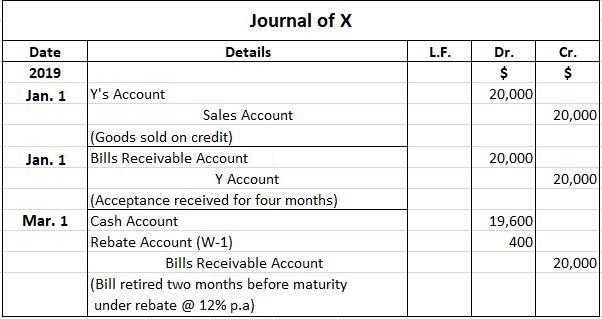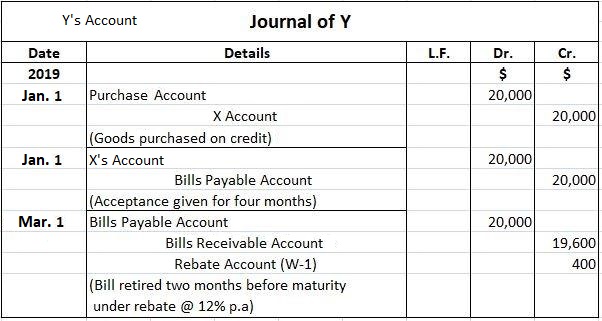When a drawee withdraws a bill of exchange from circulation by paying the amount of the bill before its maturity, this is known as retiring a bill of exchange. From the drawee's perspective, the drawee either pays or dishonors the bill on the due date. However, there is another option available to the drawee, which is known as retiring the bill of exchange. When drawee makes the payment of the bill before maturity, the drawer allows some discount to the drawee, which is known as a rebate. A rebate is a concession or discount allowed by the holder of the bill to the drawee in return for paying the amount of the bill before maturity. It is an expense for the holder and an item of revenue for the drawee. From the holder's point of view, a rebate is considered a discount allowed, whereas it is a discount received from the drawee's perspective. On 1 January 2019, X sold goods to Y for $20,000 on credit. On the same date, X drew a bill payable after four months on Y. The bill was accepted by Y and returned to X. After two months, Y wanted to pay the bill. X agreed and Y paid the bill under a rebate of 12% p.a. Required: Make journal entries in the books of X and Y. W-1:
Retiring a Bill of Exchange: Definition
Retiring a Bill of Exchange: Explanation
Rebate: Definition and Explanation
Example



Retiring a Bill of Exchange Under Rebate FAQs
Retiring a Bill Of Exchange is when the drawee withdraws it from circulation by paying the amount of the bill before its maturity.
The following are some of the terms that can be used when retiring a bill: - rebate (payment made by drawee to holder of bill in return for paying the amount of the bill before maturity) - discount (a reduction in price allowed by a buyer to a seller, or by a creditor to a debtor) - premature payment (payment of bill before it becomes due)
The drawee might choose to retire a bill in order to get a rebate from the holder. This is an expense for the holder and an item of revenue for the drawee.
A rebate is a concession or discount allowed by the holder of the bill to the drawee in return for paying the amount of the bill before maturity. A discount is a reduction in price allowed by a buyer to a seller or by a creditor to debtor.
Renewing a Bill Of Exchange is when it can be extended beyond its original due date. To renew a Bill Of Exchange, the holder has to request for an extension beyond the existing due date.
True Tamplin is a published author, public speaker, CEO of UpDigital, and founder of Finance Strategists.
True is a Certified Educator in Personal Finance (CEPF®), author of The Handy Financial Ratios Guide, a member of the Society for Advancing Business Editing and Writing, contributes to his financial education site, Finance Strategists, and has spoken to various financial communities such as the CFA Institute, as well as university students like his Alma mater, Biola University, where he received a bachelor of science in business and data analytics.
To learn more about True, visit his personal website or view his author profiles on Amazon, Nasdaq and Forbes.











